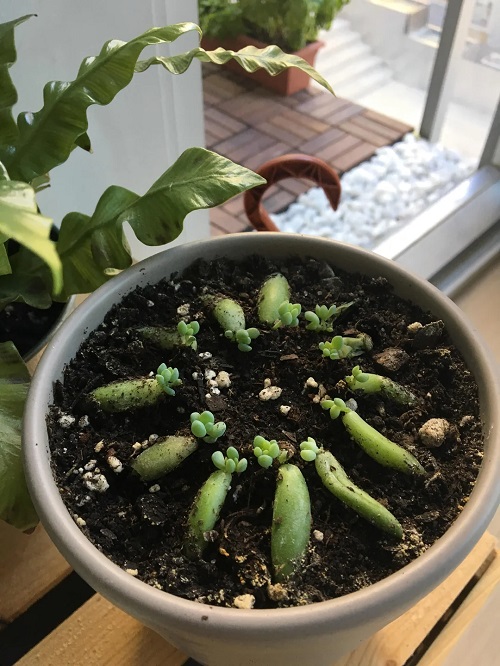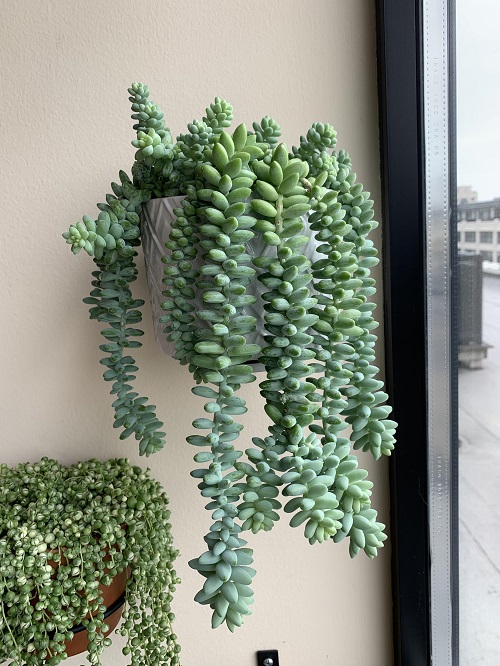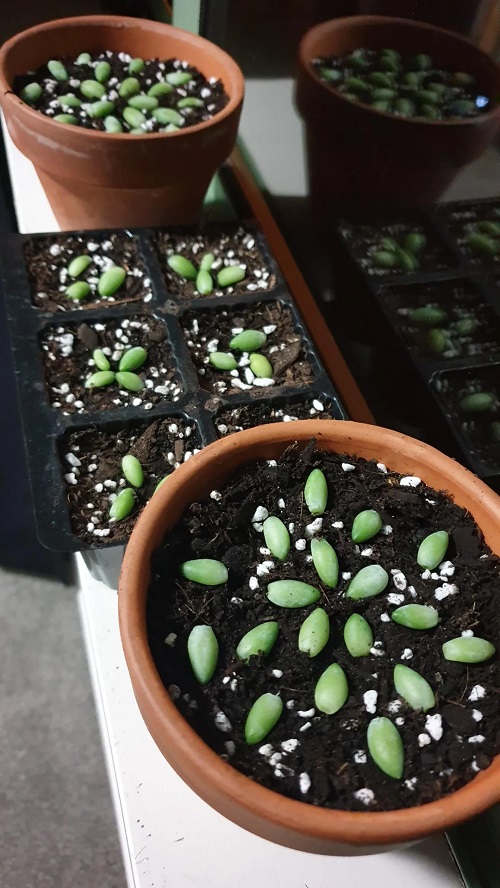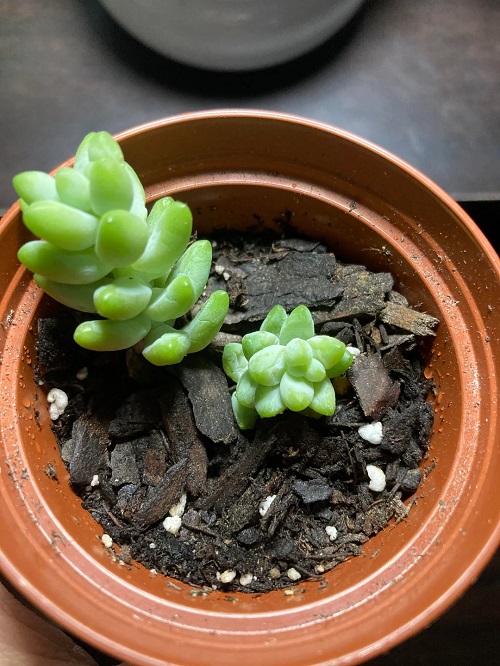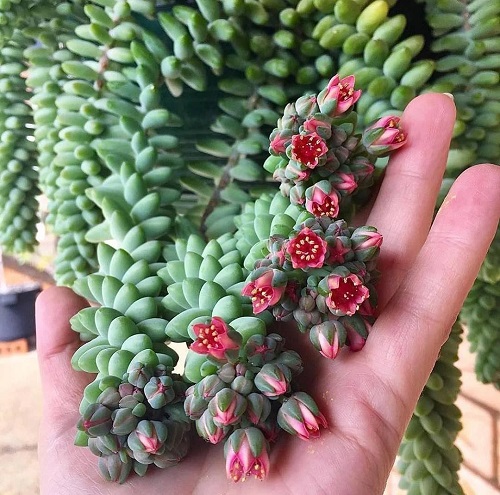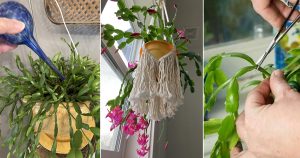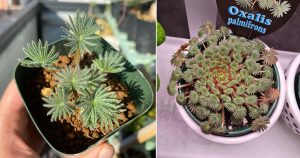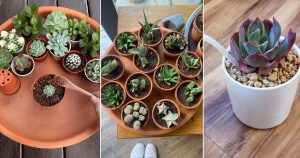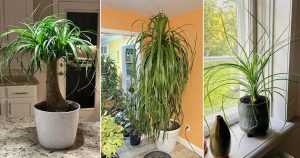Want a beautiful hanging plant? Check out this guide on Donkey Tail Succulent Care and Propagation to make your home even more attractive!
As this plant is completely safe and non-toxic to pets and humans, if you want to grow your burro’s tail lush and green, just follow these Donkey Tail Succulent Care and Propagation tips. Check it out!
Donkey Tail Succulent —Key Facts
| Common Names | Donkey’s tail, burro’s tail, lamb’s tail |
| Botanical Name | Sedum morganianum |
| Origin | North America, Central America |
| Height | 1–4 ft. long, 1–2 ft. wide |
| Indoor/ Outdoor | Both |
| Soil | Loamy, sandy with alkaline, neutral pH |
| Temperature | 65 to 75 °F |
| Watering | Once every two or three weeks |
| Sunlight | Full, partial |
| Flowers Color | Red, white, yellow |
| Blooming Season | Summer, but the plant flowers rarely indoors |
Donkey Tail Succulent Information
Donkey Tail is a perennial succulent native to Honduras and Mexico. This plant is slow-growing and takes at least six years to reach its maximum height, which is approximately 4 feet. It features trailing stems with fleshy, tear-drop-shaped, blue-green leaves.
Gardeners prefer to grow it in hanging pots indoors due to ease of maintenance and to admire its beauty. It can be easily propagated anytime in the year with stem cuttings or dropped leaves. If you want to keep it outdoors, you can, but the plantation must be done in early spring only!
A golden tip: Do not experiment with the plant once it is established. This succulent is a slow grower, sensitive, and takes time to adjust to the new environment, so let it grow at its own pace in its journey to develop a charming vine-like appearance.
Donkey Tail Succulent Pot Size
When choosing a pot size, you must look primarily for a pot that is strong, durable, adequate size (neither too big nor too small), and well-draining. The donkey tail is the most brittle and delicate succulent that needs a stable pot to avoid unavoidable trips due to its trailing vines, which become heavy as they grow.
This plant does not like to hold prolonged moisture in its growing medium, which can lead to root rot. So, a 5-7 inches terracotta or clay pot with well-draining holes will be best for propagating a single plant.
Do Re-Potting With Extra Care
As you know, it has a vine-like structure, so shifting the plant from one container to another is impossible. You have to break the existing container, and then the entire plant, along with the root ball, will get planted into a new one. Doing so includes the risk of damaging its several “tails’.
So, to safeguard its fragile beauty, it would be better to avoid repotting this plant. However, if necessary, be very careful and choose a bigger container. Let the plant settle in the soil before the first irrigation. Fertilize after 2-3 weeks only.
How to Propagate Donkey Tail Succulent
Donkey tail succulent care and propagation is quite easy. You can grow it with seeds, stem cutting, or leaf cutting. Here, we will explain the stem or leaf-cutting methods with all do’s and don’ts.
1. Propagating With Stem Cutting:
Using a sterile knife or scissors, cut off a healthy stem with fleshy leaves. It should be 2-3 inches long. Remove the bottom few leaves. Keep the cutting in a place with bright light in a shallow box to develop a callus ( a thick protective layer). It will take 2-3 weeks. The identification key would be to look for the cut marks. If they look dry and sealed, then transplant the cutting in the pot filled with cacti or succulent potting mix.
Place it in a space with bright, indirect light, and provide water when the soil feels dry to you. However, some gardeners even prefer to put the cutting directly into the soil and skip this callus part.
2. Donkey Tail Succulent Propagation from Leaves:
You will see its plumy leaves falling off with even the slightest touch, so collect the healthy ones, discard the shriveled or damaged leaves, and put them aside for 2-3 weeks for callus emerging from the skin. After that, lay down the leaves in the pot with succulent mix or cacti.
Sprinkle water once a week to maintain moisture until you see new growth emerging; do not let the soil become soggy. Once you see it growing well, treat it like an established plant.
Requirements for Growing Donkey Tail Succulent
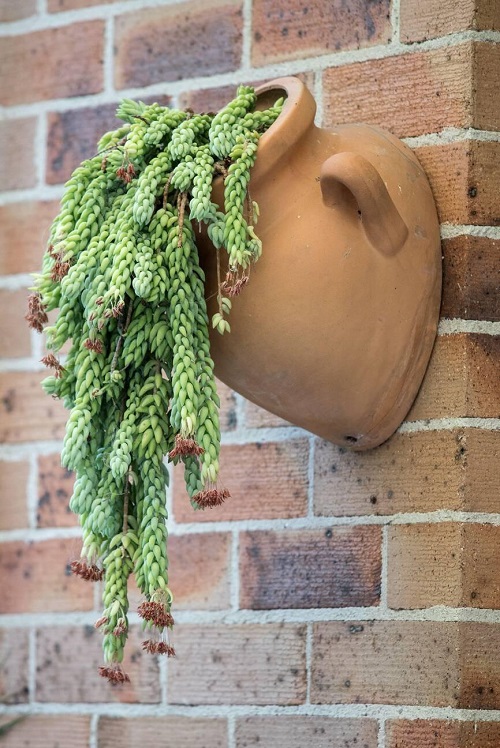
Sunlight
The Donkey tail needs a sunny windowsill if grown indoors so that it gets lots of warm sunlight daily, especially the morning sunshine. Afternoon shade can be harmful for the leaves. Similarly, follow the light requirements for outdoors as well.
Soil
A well- draining, sandy or gritty soil mixture made with cacti or succulents is best for donkey tail. Plus, it thrives best in the soil with neutral to alkaline pH.
Watering
This succulent has fleshy leaves which store water for its survival. You need to protect the plant from being overwatered, which will lead to loose leaves, stems and cause root rot. Let the soil dry out after each irrigation. Also, the plant’s leaves will look somewhat flattened/wrinkled like raisins when they need water.
Additionally, you need to give more attention to watering during spring and summer followed by reducing in winter and omit when you see the dormancy.
Temperature and Humidity
Donkey tail needs warm conditions with 50-75°F temperature indoors or outdoors. During winter you must bring your plant indoors, keep the house ones away from drafty windows or AC vents, particularly areas where it can receive cold drafts.
It requires average humidity, excess can lead to rot. So, no need for any additional humidifier or misting for this succulent. But, remember that it can’t handle temperatures below 40°F (5 °C).
Location
You already know that the dangling stems of donkey tails’ are fragile and can easily be affected with slight winds or sudden shake. Keep it away from such locations, rather place it on a spot where its stems and foliage remain protected.
Donkey Tail Succulent Care
Fertilizer
Additional feed is not necessary. If you want, then you can as it does not have any negative effects on the plants health. But it should be done only in the growing season with a balanced ratio 20-20-20 of nitrogen, potassium and phosphorus.
Tip: When fertilizing the younger plant, add less quantity of nitrogen compared to other essential nutrients.
Pruning
To multiply the beauty of dangling stems and leaves of your donkey tails’ succulent you must prune the old, overgrown fatty stems. Simple!
Pests and Diseases
Generally, the dangers of pests is negligible in donkey tail. But aphids, mealybugs can be observed, particularly indoors. Don’t worry you can get rid of them by applying neem oil on the surface of the succulent. Outdoors, it can be attracted by slugs or snails that you can easily handle by picking them off or by using baits. Plus, preventing the plant from overwatering, it can become the major way to attract a lot of diseases.
How to Make a Donkey Tail Flower?
Donkey tail blooms on maturity with clusters of small star-shaped flowers on slender pedicles. You will not or rarely see this plant blooming indoors. Outdoors, it will showcase flowers in shades of white, yellow or red only after getting at least 25 cm long stems in plenty of sunlight, during late spring or summer.
Trick: Little bit of stress can encourage the blooming, exposing the plant to cooler temperatures around 50-60ºF outdoors.

